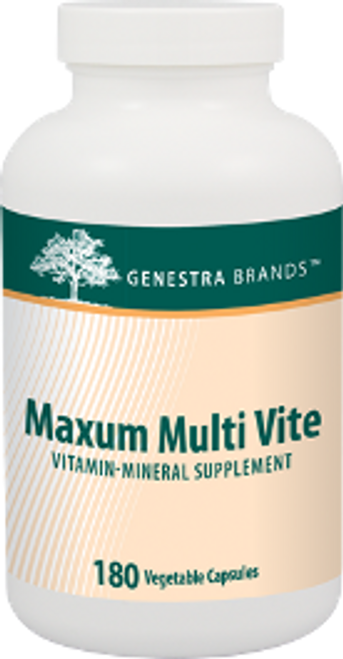Product Overview
Genestra Maxum Multi Vite- 90 capsules
• Complete multivitamin mineral formulation in capsules • With rutin, coenzyme Q10 and green tea extract • Ideal for vegetarians • Convenient capsule format increase patient compliance
Maxum Multi Vite provides a well-balanced combination of vitamins and minerals along with a wide range of antioxidants to assist and promote overall health. The capsules are 100% pure vegetable-sourced. Ideal for vegetarians.
Additional product info: Aging is accompanied by a variety of physiological, psychological, economic and social changes that compromise nutritional status and/or affect nutritional requirements. For these reasons, the diets of many older adults do not currently meet the recommended intake levels of several essential vitamins and minerals; thus, low micronutrient status is often reported in this population. Nutritional status surveys of the elderly indicate a low to moderate prevalence of frank nutrient deficiencies, but an increased risk of malnutrition, along with evidence of subclinical deficiencies having a direct impact on physiologic function. Overt micronutrient deficiencies have been reported as prevalent in nursing home populations, and recommendations were made that all institutionalized older adults receive a multivitamin/mineral supplement for general nutritional prophylaxis. A clinical study has shown that multivitamin treatment for 8 weeks significantly increased, compared to placebo, plasma concentrations of vitamins D, E, pyridoxal phosphate, folate, B12, C, and improved the riboflavin activity coefficient. Supplementation with a multivitamin formulated at about 100% Daily Value can thus decrease the prevalence of suboptimal vitamin status in older adults and improve their micronutrient status to levels associated with reduced risk for several chronic diseases (1). The NHPD recommendations for zinc supplementation in adults to help maintain healthy skin are between 0.7-50 mg per day (2).
Calcium and vitamin D are both essential for the development and maintenance of skeletal health. Calcium plays a vital role in neuromuscular function, many enzyme-mediated processes, blood clotting and in providing rigidity to the skeleton by virtue of its phosphate salts. Over 99% of the body’s calcium is stored in the bone, where, apart from providing mechanical strength, it serves as a mineral reservoir that can be drawn upon to maintain normal plasma calcium. Vitamin D is required to maintain normal blood levels of calcium and phosphate, which are in turn needed for the normal mineralization of bone, muscle contraction, nerve conduction and the general cellular functioning of all body cells. Vitamin D, derived from both endogenous (skin) and exogenous (diet) sources, is converted into 25OHD in the liver and then into 1,25(OH)2D in the kidneys. The latter metabolite controls calcium absorption. However, plasma 25OHD closely reflects vitamin D nutritional status, and because it is the substrate for the renal enzyme that produces 1,25(OH)2D, it could have mainly an indirect and also a direct effect on calcium absorption. A vitamin D shortage would reduce the intestinal absorption of calcium, which could worsen if the diet is deficient of this element. Osteoporosis and its clinical consequence, fragility fractures, are now recognized as major public health problems. Bone mass declines and the risk of fractures increases as people age, especially postmenopausal women. An adequate intake of calcium and vitamin D, including supplementation, has been advocated as a universal primary intervention in the prevention and treatment of high-risk patients. Evidence shows that there is still a high proportion of people with inappropriately low calcium and vitamin D intake and serum levels. For selective groups of people, such as the elderly (frequently older than 70 years), those with low solar exposure and in generally poor or inadequate nutritional condition, guaranteeing a daily intake of at least 1 g of calcium and 700–800 IU of vitamin D with supplements would have beneficial effects on bone health. In those individuals with a high risk of osteoporotic fracture, calcium and vitamin D supplements are necessary but frequently insufficient (3).
The B vitamins folate, vitamin B6 (pyridoxine), and vitamin B12 (cobalamin) are important regulators of homocysteine metabolism in the body, and randomized controlled trials have demonstrated that supplementation with folate at doses up to 500 µg daily (natural dietary folate or the synthetic folic acid) alone or in combination with vitamins B6 and B12 significantly reduces blood homocysteine concentrations (4). Epidemiological evidence suggests that total plasma homocysteine level is an independent cardiovascular risk factor. Studies on the pathogenesis of homocysteine-induced vascular damage have suggested adverse interaction with vascular smooth muscle cells, endothelium function, plasma lipoproteins, and coagulation cascade. A study provides evidence that homocysteine-lowering therapy with folic acid (1 mg/d), vitamin B12 (cyanocobalamin, 400 ?g/d), and vitamin B6 (pyridoxine hydrochloride, 10 mg/d) for 6 months improves outcome after percutaneous coronary intervention. These results are consistent with those of recent randomized trials with homocysteine-lowering therapy (5). In a large cohort of male Finnish smokers, a high dietary folate intake was associated with a significantly lower risk of cerebral infarction (6).
Adequate zinc status is critical for immune function. Zinc deficiency reduces generation of T cells, depresses humoral and cell-mediated immunity, leads to lymphopenia and thymic atrophy, and increases the frequency and number of infections. A prospective, randomized, controlled clinical trial was conducted involving 231 HIV-infected adults with low plasma zinc levels, who were randomly assigned to receive zinc (12 mg of elemental zinc for women and 15 mg for men) or placebo for 18 months. Zinc supplementation given to HIV-infected adults resulted in a 4-fold decrease in the likelihood of immunological failure, defined as a decrease of CD4+ cell count to <200 cells/mm3, after 18 months of use, compared with placebo. Zinc supplementation also significantly reduced diarrhea, compared with placebo (7). Chromium (Cr) is an essential element required for normal carbohydrate and lipid metabolism. Signs of Cr deficiency have been documented on numerous occasions, including elevated blood glucose, insulin, cholesterol and triglycerides, and decreased high density lipoproteins (HDL) in humans consuming normal diets. A review reports that the response to Cr supplementation for glucose, insulin, lipids, and related variables is related to the amount and form of supplemental Cr, the degree of glucose intolerance, and the duration of the study. Subjects with glucose intolerance but not diabetes usually respond to 200 µg of Cr daily as Cr chloride or other more bioavailable forms of Cr (8). The NHPD recommendations for chromium supplementation in adults to provide support for healthy glucose metabolism are between 2.2-500 µg per day (9).
Oxidative stress also plays an important role in the pathogenesis of cardiovascular disease (CVD). Growing evidence suggest that antioxidant vitamins might reduce the risk of disease outcomes by their ability to scavenge free radicals. A case-control study with vitamin E (400 IU/d) and vitamin C (500 mg/d) supplementation in 40 CVD patients for 2 months showed reduced lipid peroxidation and a strengthened antioxidant defense system. Hence, vitamin E and vitamin C supplementation may have beneficial effects on the heart by reducing oxidative stress in CVD patients (10). Selenium (11), Coenzyme Q10 (12) and Green Tea extract (13) are other antioxidants included in Maxum Multi Vite.
Attributes of Maxum Multi Vite covered by the NHPD Monographs: An antioxidant for the maintenance of good health. Helps in the development and maintenance of bones, cartilage, teeth, gums and night vision; provides support for healthy glucose metabolism; helps the body to metabolize carbohydrates, fats and proteins; helps in the function of the thyroid gland, in wound healing and normal growth and development; helps in tissue, connective tissue and red blood cell formation; helps to maintain eyesight, healthy skin, membranes, immune and proper muscle function; helps to prevent vitamins C, E, B6, B12, pantothenic acid, biotin, thiamine, riboflavin, manganese, chromium and selenium deficiencies. Calcium intake, when combined with sufficient vitamin D, a healthy diet, and regular exercise, may reduce the risk of developing osteoporosis (14).
References: 1 McKay DL, Perrone G, Rasmussen H, Dallal G, Hartman W, Cao G, Prior RL, Roubenoff R, Blumberg JB. The effects of a multivitamin/mineral supplement on micronutrient status, antioxidant capacity and cytokine production in healthy older adults consuming a fortified diet. J Am Coll Nutr. 2000 Oct;19(5):613-21. Abstract; Page 613, Introduction; Page 616, Water-Soluble Vitamins, 1st paragraph 2 NHPD Monograph on Multivitamin and Mineral. October 2007. 3 Díaz-López B, Cannata-Andía JB. Supplementation of vitamin D and calcium: advantages and risks. Nephrol Dial Transplant. 2006 Sep;21(9):2375-7. Page 2375, Introduction, 1st, 3rd and 4th paragraphs; Page 2376, last 2 paragraphs 4 Larsson SC, Männistö S, Virtanen MJ, Kontto J, Albanes D, Virtamo J. Folate, vitamin B6, vitamin B12, and methionine intakes and risk of stroke subtypes in male smokers. Am J Epidemiol. 2008 Apr 15;167(8):954-61. Abstract; Page 954, 2nd paragraph; Page 957, Discussion, 1st sentence 5 Schnyder G, Roffi M, Flammer Y, Pin R, Hess OM. Effect of homocysteine-lowering therapy with folic acid, vitamin B12, and vitamin B6 on clinical outcome after percutaneous coronary intervention: the Swiss Heart study: a randomized controlled trial. JAMA. 2002 Aug 28;288(8):973-9. Page 973, Abstract; Page 973, Introduction, 1st paragraph; Page 977, Comment, 1st paragraph 6 Larsson SC, Männistö S, Virtanen MJ, Kontto J, Albanes D, Virtamo J. Folate, vitamin B6, vitamin B12, and methionine intakes and risk of stroke subtypes in male smokers. Am J Epidemiol. 2008 Apr 15;167(8):954-61. Abstract; Page 954, 2nd paragraph; Page 957, Discussion, 1st sentence 7 Baum MK, Lai S, Sales S, Page JB, Campa A. Randomized, controlled clinical trial of zinc supplementation to prevent immunological failure in HIV-infected adults. Clin Infect Dis. 2010 Jun 15;50(12):1653-60. Abstract; Page 1653, 1st paragraph;Page 1657, Discussion, 1st paragraph; Page 1658, Conclusion 8 Anderson RA. Chromium, glucose intolerance and diabetes. J Am Coll Nutr. 1998 Dec;17(6):548-55. Page 548, Introduction, 1st paragraph; Page 553, Summary, 1st paragaph 9 NHPD Monograph on Multi-Vitamin and Mineral. October 2007. 10 Karajibani M, Hashemi M, Montazerifar F, Dikshit M. Effect of vitamin E and C supplements on antioxidant defense system in cardiovascular disease patients in Zahedan, southeast Iran. J Nutr Sci Vitaminol (Tokyo). 2010;56(6):436-40. Abstract; Page 436, Introduction, 1st paragraph; Page 439, Conclusion 11 NHPD Monograph on Multi-Vitamin and Mineral. October 2007. 12 NHPD Monograph on Coenzyme Q10. November 2007. 13 NHPD Monograph on Green Tea Extract. April 2008. 14 NHPD Monograph on Multivitamin and Mineral. October 2007.
Other ingredients: hypromellose, microcrystalline cellulose, magnesium silicate, magnesium stearate, silica








